Stylidium diceratum is a dicotyledonous plant that belongs to the genus Stylidium. The specific epithet diceratum is Greek for "two horns", referring to the two appendages that are present on the bend of the gynostemium. It is an annual plant that grows from 15 to 35 cm tall. The longer leaves are lanceolate and the shorter ones are spathulate, forming a basal rosettes around the stem. The leaves are around 5–8 mm long and 0.2-2.5 mm wide. Inflorescences are around 6–15 cm long and produce flowers that are orange with dark orange and pink veins and bloom from June to August in their native range. S. diceratum is only known from the type location, which is at creek crossings on the road to Beverley Springs in the Kimberley region of Western Australia. Its habitat is recorded as being sandy soils on creek margins. It grows in the presence of S. ceratophorum, S. rubriscapum, Drosera caduca, D. paradoxa, Byblis liniflora, and Grevillea pteridifolia. S. diceratum is most closely related to S. longicornu, but it can be confused with S. ceratophorum, which also has an orange corolla but twice as large.

Drosera ramellosa, sometimes referred to as the branched sundew, is a tuberous perennial species in the genus Drosera that is endemic to Western Australia. It was first formally described by Johann Georg Christian Lehmann in 1844. It was again described by Jules Émile Planchon as Drosera penduliflora in 1848, which was reduced to synonymy under D. ramellosa in 1864 by George Bentham.
Drosera prostratoscaposa is a perennial tuberous species in the genus Drosera that is endemic to Western Australia. It grows in a rosette about 8 cm in diameter. It is native to a small area in the Fitzgerald River National Park 40 km south-east of the South Coast Highway in between Albany and Esperance. It grows in fine black sandy soils. It is considered to be closely related to D. macrophylla and D. bulbosa, but differs from these by the presence of multiple jasmine-scented flowers on its scapes and petiolate leaves.

Drosera macrophylla, the showy sundew, is a perennial tuberous species in the genus Drosera that is endemic to Western Australia. It grows in a rosette with leaves 4 cm (2 in) long and 2 cm (1 in) wide. It is a common species east of Perth. It grows in loam soils. It flowers from June to October. D. macrophylla was first described by John Lindley in his 1839 publication A sketch of the vegetation of the Swan River Colony. In 1992, Allen Lowrie and Sherwin Carlquist described a new subspecies, D. macrophylla subsp. monantha, which is distinguished from D. macrophylla subsp. macrophylla by its single-flowered or rarely biflowered inflorescences. Subspecies monantha is abundant in the Bruce Rock/Merredin region.

Drosera erythrorhiza, the red ink sundew, is a perennial tuberous species in the carnivorous plant genus Drosera that is endemic to Western Australia. It grows in a rosette and is distinguished from the other species in section Erythrorhiza by its many-flowered cymose inflorescences with up to 50 individual flowers. D. erythrorhiza was first described by John Lindley in his 1839 publication A sketch of the vegetation of the Swan River Colony. In 1992, N. G. Marchant and Allen Lowrie described three new subspecies, thus also creating the autonym D. erythrorhiza subsp. erythrorhiza. The subspecies were separated from this variable species mostly by leaf morphology and distribution.

Drosera bicolor is an erect perennial tuberous species in the genus Drosera that is endemic to Western Australia. It produces a basal rosette of leaves similar to that of D. peltata and the stem grows to 11 cm (4 in) high. Its white flowers that have a red spot near the petal base emerge from September to October. D. bicolor grows in deep silica sand on heathland along the upper Phillips River and south-east of Lake King.
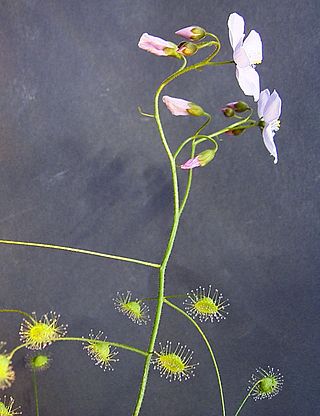
Drosera macrantha, the bridal rainbow, is a scrambling or climbing perennial tuberous species in the carnivorous plant genus Drosera that is endemic to Western Australia. It grows in a variety of habitats, including winter-wet depressions in sandy, loamy, laterite, or quartzite soils. D. macrantha produces small, cup-shaped carnivorous leaves along a long stem that can be 0.16–1.5 m (0.5–4.9 ft) high as it climbs. Its 1 in (2.5 cm) white or pink flowers emerge from June to November, blooming earlier in the more northern range.

Drosera menziesii, the pink rainbow, is an erect or scrambling perennial tuberous species in the carnivorous plant genus Drosera. It is endemic to Western Australia and grows in a variety of habitats, including winter-wet depressions, swamps, and granite outcrops in clay or peat sand soils or loam. D. menziesii produces small, circular carnivorous leaves along an undulating erect stem that can be .05–1.1 m (0.2–3.6 ft) high. Its pink flowers emerge from July to November.
Drosera moorei is a scrambling or climbing perennial tuberous species in the carnivorous plant genus Drosera. It is endemic to Western Australia and grows near granite outcrops in sandy loam. D. moorei produces small, circular, peltate carnivorous leaves along glabrous stems that can be 12–35 cm (5–14 in) long. Inflorescences have two to ten yellow flowers and bloom from September to October.
Drosera subtilis is an erect annual species in the carnivorous plant genus Drosera. It is native to northern Western Australia and a single site in the Northern Territory. In Western Australia, it has been collected from Beverley Springs Station, Bigge Island, and the Mitchell Plateau area all in the vicinity of the Kimberley region. In the Northern Territory, it has been found near Little Nourlangie Rock. It grows over sandstone near seepage margins in skeletal sandstone sand and black humus mixed soils. D. subtilis is anchored to the soil by a system of thin, fleshy roots and it lacks a tuber. It produces small carnivorous leaves along erect, reddish stems that can be 20 cm (8 in) high.
Drosera zigzagia is an erect perennial tuberous species in the carnivorous plant genus Drosera. It is endemic to Western Australia and is found on the margins of salt lakes in brown sandy loam, often associated with D. salina, Stylidium insensitivum, S. pulviniforme, Levenhookia leptantha, and Frankenia species. Drosera zigzagia produces small, solitary carnivorous leaves that alternate along a zigzag stem, which can be 5–7 cm (2.0–2.8 in) high. Yellow flowers are borne on 4–9-flowered inflorescences that bloom from August to September.
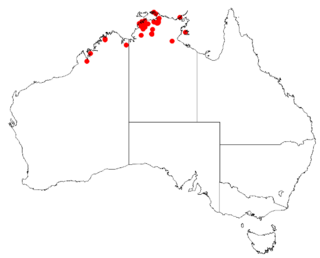
Drosera brevicornis is a small, perennial carnivorous plant in the genus Drosera that is native to the Northern Territory and Western Australia. It grows on gravel slopes and produces white to pink flowers in March and April. It was first described by Allen Lowrie in 1996, though earlier specimens from as early as 1961 had been collected. The specific epithet brevicornis means "short horned" and refers to the horn-like projection above the anthers. It is closely related to Drosera fulva.
Drosera caduca is a perennial carnivorous plant in the genus Drosera that is endemic to Western Australia. Its leaves are arranged in a rosette with one or more rosettes emerging from the root stock. It produces white flowers from December to July. Drosera caduca grows in white sandy soils on creek margins from the Edkins Range to the southern part of the Prince Regent National Park and also on Augustus Island. It was first described by Allen Lowrie in 1996; the type specimen was collected from August Island on 27 May 1993. The specific epithet caduca comes from the Latin caducus meaning dropping off early, in reference to the absence of the insect-trapping trichomes on all but the juvenile leaves. This plant is unique in the genus by its lack of the sticky traps on the mature adult leaves.

Drosera darwinensis is a perennial carnivorous plant in the genus Drosera that is endemic to the Northern Territory. Its leaves are arranged in a rosette with one rosette emerging from the root stock. It produces pink or white flowers from December to April. Drosera darwinensis grows in clayey sand from Palmerston to Berry Springs south of Darwin and east to Humpty Doo. It was first described by Allen Lowrie in 1996; the type specimen was collected 0.9 km (0.6 mi) south of Temple Avenue in Palmerston on 8 April 1990. The specific epithet darwinensis refers to region where this plant is found in abundance. It is closely related to D. brevicornis, but differs from that species by its shorter inflorescence.

Drosera derbyensis is a perennial carnivorous plant in the genus Drosera and is endemic to Western Australia. Its erect or semi-erect leaves are arranged in a rosette with one or more rosettes emerging from the root stock. The petioles are narrowly oblanceolate, 0.8–1.0 mm wide at the proximate end and 1.3–1.7 mm wide at the apex(wiki), narrowing to 0.5–0.7 mm at the laminar base. The petioles are frequently 35–45 mm long when the plant is in flower and are covered in white woolly non-dendritic hairs. The insect-trapping leaf lamina is orbicular and much shorter than the petioles at only 2–3 mm in diameter. The laminar adaxial surface is covered in insect-trapping glands. Each rosette produces 1–4 raceme inflorescences, which are 25–35 cm (10–14 in) long. Each inflorescence bears 30–50 white flowers, with flowering occurring from March to June. The upper portion of the scape and the abaxial surface of the sepals are covered with white woolly non-dendritic hairs. Its roots are fibrous. Drosera derbyensis grows in sandy soils in floodways or near rock outcrops from Derby to Beverley Springs in the Kimberley region.
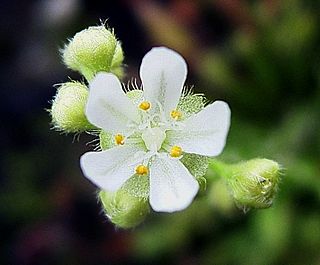
Drosera dilatato-petiolaris is a carnivorous plant in the genus Drosera and is endemic to Australia, being found in both Western Australia and the Northern Territory. Its leaves are arranged in a rosette and commonly produces plantlets, eventually forming large clumps that can be over 1 ft (0.3 m) across. Green petioles emerging from the center of the rosette are typically 3–5 mm wide, but can vary. Red carnivorous leaves at the end of the petioles are small and round, with most resting on the soil surface. Inflorescences are 18 cm (7 in) long with white flowers being produced from April to May. It has a diploid chromosome number of 2n = 12.
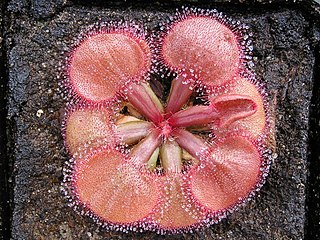
Drosera falconeri is a carnivorous plant in the family of Droseraceae. It is endemic to the Northern Territory of Australia.
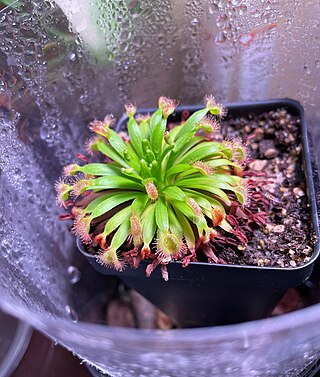
Drosera fulva is a carnivorous plant in the genus Drosera and is endemic to the Northern Territory in Australia. Its semi-erect or prostrate leaves are arranged in a compact basal rosette. Oblanceolate petioles emerging from the center of the rosette are typically 2–3 mm wide at its widest. Red carnivorous leaves at the end of the petioles are small and round at 2–3 mm in diameter. Inflorescences are 25–45 cm (10–18 in) long with white or sometimes pink flowers being produced on 50-or-more-flowered racemes from February to May.

Drosera kenneallyi is a carnivorous plant in the genus Drosera and is endemic to the Kimberley region in northern Western Australia. Its leaves are arranged in a compact basal rosette appressed to the soil. Narrowly oblanceolate petioles emerging from the center of the rosette are typically 1.5–2.2 mm wide at their widest. Red carnivorous leaves at the end of the petioles are small at 2–3 mm in diameter and elliptic to broadly ovate. Inflorescences are 12.5–20.5 cm (5–8 in) long with white flowers being produced on 10- to 20-flowered racemes from November to December.

Drosera paradoxa is a carnivorous plant in the genus Drosera and is endemic to the Northern Territory and Western Australia. It is a perennial herb with a woody stem that can grow as tall as 30 cm (12 in). The leaves on the single terminal rosette are erect or horizontal and held at the end of linear petioles, which are typically 20–35 mm long at flowering time. The carnivorous leaves are sub-orbicular and small at 2.5–3 mm wide and 2–3 mm long. Inflorescences are 20–40 cm (8–16 in) long with pink or white flowers being produced on 50- to 70-flowered crowded racemes from July to September during the dry season.















